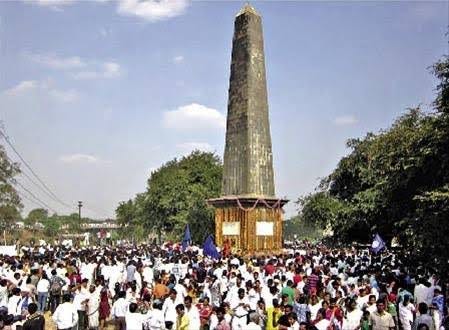Truths And Lies About 500 Mahar Soldiers Defeating 28000 Strong Army Of Peshwas
 |
Vijay Sthamb (victory pillar) - The pillar was erected by the East India Company in memory of those who fought the battle and includes the names of the Mahar soldiers who unknowingly brought an end to the Peshwa rule in 1818. |
The battle on January 1, 1818, where the British, with just 834 infantrymen — about 500 of them from the Mahar community — and 12 officers defeated the 28,000-strong army of Peshwa Bajirao II - was one of the last battles of the Third Anglo-Maratha War, which ended the Peshwa domination.
While this would tempt many to suggest Mahars/Dalits always sided with the British - absolutely nothing wrong if they did give the conditions they were forced to live in - in truth, they were before this battle part of the Maratha army. During Shivaji’s reign, especially before Peshwas, many didn’t realise that Peshwas were not a continuation of Marathas under Shivaji but a deviation from it. One would do well here to remember how Brahmins of his dominion refused to conduct the coronation ceremony of Shivaji.
The Brahmins of Shivaji’s court refused to crown Shivaji as a king because that status was reserved for those of the Kshatriya varna (warrior class) in Hindu society. Shivaji was descended from a line of headmen of farming villages, and the Brahmins accordingly categorised him as a Maratha, not a Kshatriya. They noted that Shivaji had never had a sacred thread ceremony, and did not wear the thread, such as a kshatriya would. Shivaji summoned Gaga Bhatt, a pandit of Varanasi, who stated that he had found a genealogy proving that Shivaji was descended from the Sisodias, and thus indeed a Kshatriya, albeit one in need of the ceremonies befitting his rank. To enforce this status, Shivaji was given a sacred thread ceremony and remarried his spouses under the Vedic rites expected of a Kshatriya. However, according to historical evidence, Shivaji’s claim to Rajput, and specifically of Sisodia ancestry, may be seen as being anything from tenuous, at best, to purely inventive. The Brahmins of his dominion did not buy into these claims until Shivaji essentially paid and bought their approval. And these payments happened repeatedly leading up to his coronation. He would pay and then Brahmins would invent new excuses to refuse, and Shivaji would pay them again, all summing up to some million rupees from his treasury.
Relations between the Mahars and the Peshwas, who were Brahmins, grew strained after the death of Baji Rao I in 1740 and reached their nadir during the reign of Bajirao Rao II, who insulted the Mahar community and spurned their offer of service with his army. This caused them to side with the English against the Peshwa’s numerically superior army.
Textbooks not mentioning one or the other events from history are a favourite topic of right-wing groups in India. But notice how, although in school textbooks they mention in detail about Anglo-Maratha wars and even Peshwas, they omit the Bhima-Koregaon battle where a few Mahars defeated a large army of Peshwas ending their tyranny!


Comments
Post a Comment